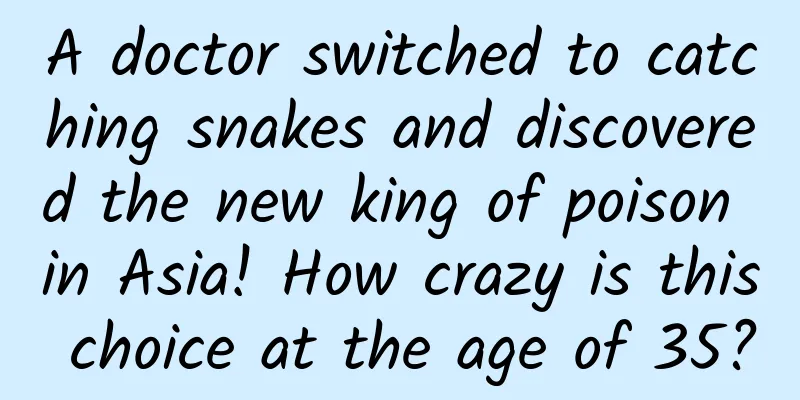A doctor switched to catching snakes and discovered the new king of poison in Asia! How crazy is this choice at the age of 35?

|
2025 is the Year of the Snake in the Chinese lunar calendar. When this animal is mentioned, some people shudder reflexively, while others think it is "extremely poisonous". Four years ago, Ding Li, an associate researcher at the Chengdu Institute of Biology, Chinese Academy of Sciences, and his team announced a new snake species - the Suzhen Ring Snake. The toxicity of this snake even surpasses the "old venomous king" of Asian terrestrial venomous snakes, the Bungarus multicinctus, and is recognized as the "new venomous king" of Asian terrestrial snakes. The discovery of the Suzhen Krait not only made Ding Li famous in the field of snake research, but also made him an important figure in the study of Asian venomous snakes. However, Ding Li did not start his snake research career. He was a clinician, but at the age of 35, he resolutely resigned and went south to Sichuan to devote himself to snake research. What made him give up his stable job as a doctor and choose this dangerous and challenging scientific research path? Suzhen Ring Snake A bond with snakes Ding Li's fate with snakes can be traced back to his youth. More than 30 years ago, when he was still in junior high school, Ding Li bought a book called "Chinese Snakes Illustrated Book" in Beijing Wangfujing Bookstore. Although only 2,000 copies of this book were issued and the price was not cheap, for Ding Li, it was a treasure worth collecting. He read it over and over again, and every snake in the book was deeply imprinted in his mind. He could even tell the page number and characteristics of any snake in the book. At that time, Ding Li was full of yearning for snake research. When he learned that the editor-in-chief of "Chinese Snake Atlas" worked at Zhejiang Medical University (now Zhejiang University School of Medicine), he had the idea of becoming his apprentice. Although there were almost no majors specializing in snake research in China at that time, Ding Li still wrote down the name of Zhejiang Medical University on his college entrance examination application form. Unfortunately, his college entrance examination score did not meet the admission requirement of Zhejiang Medical University, and he was eventually transferred to Capital Medical University to study clinical medicine. During his college years, Ding Li studied clinical medicine, but his interest in snakes never waned. Whenever he had free time, he would go to the mountains around Beijing to catch snakes, raise snakes, and make specimens. In the eyes of his classmates, he was more like an animal expert than a future doctor. After graduation, Ding Li naturally became a clinical doctor, but his passion for snake research never extinguished. In 2004, 35-year-old Ding Li made a decision that surprised many people: he quit his job as a clinical doctor after eight years, left Beijing, went south to Sichuan, and joined the amphibian and reptile research team of the Chengdu Institute of Biology, Chinese Academy of Sciences. This decision was not made on impulse, but was the result of careful consideration. Ding Li believed that medicine and biology have many similarities, and he was already familiar with the characteristics of various snakes in China, so he did not think this "cross-border" was difficult. Dingli catches snakes at night Dangerous scientific research Snake research, especially venomous snake research, is full of dangers. Ding Li often needs to travel through mountains and rivers and go deep into dense forests where few people go to look for traces of venomous snakes. During a scientific expedition to the Qinling Mountains, he was bitten by a snake on the middle finger of his left hand, causing him to lie in bed for 3 days in unbearable pain. Despite this, Ding Li never regretted his choice. He said: "I would regret it if I didn't do this." In 2021, Ding Li and his team announced a new species of snake, the Suzhen Krait. The name of this snake was inspired by the mythical figure Bai Suzhen in The Legend of the White Snake. The discovery of the Suzhen Krait stems from Ding Li's keen observation of the symptoms of snake venom. He found that patients bitten by the Suzhen Krait would experience local swelling and pain, which is completely different from the symptoms after being bitten by the Bungarus. Bungarus carries a single type of neurotoxin, while after being bitten by the Suzhen Krait, the patient's symptoms are more like infection with cytotoxins or blood toxins. Through further morphological comparison and molecular phylogenetic relationship analysis, Ding Li confirmed that Suzhen Ring Snake is a new species. However, this is just the beginning of the research. The next task for Ding Li and his team is to figure out how toxic Suzhen Ring Snake is and why it is so toxic. In order to study the toxicity of Suzhen Krait, Ding Li and his team went to Yingjiang, Yunnan and other places many times to capture Suzhen Krait and extract venom. Every time they caught a snake, they would pinch the snake's head to make it bite a special vessel, allowing the venom to flow into the liquid nitrogen tank. However, the amount of venom extracted each time was very limited, only about 20 microliters. After drying, only a few milligrams of powder can be obtained. In order to conduct proteomic analysis, Ding Li and his team spent more than two years to save up about 80 mg for the experiment. Through analysis, Ding Li found that the toxin of Suzhen krait contains a high proportion of LAAO protein and SVMP protein, which may be the reason for the obvious local pain and deep poisoning after being bitten. The team also conducted a comparative experiment on the median lethal dose, and the results showed that the toxicity of Suzhen krait is more than twice that of the Bungarus bungarus and the Sindhu krait. This means that the toxins discharged by Suzhen krait at one time are enough to poison more than 10 adults. Ding Li provides popular science information for everyone on TV programs Ding Li's research is not limited to the toxicological analysis of snake venom. He is also committed to the refinement of snake bite prevention and treatment. He found that there are still misunderstandings in the treatment of snake bites in many areas, such as blindly using ropes to tie the wound or sucking out the venom with the mouth without distinguishing the snake species. These wrong methods are not only ineffective, but may also delay treatment and lead to death or disability of patients. Ding Li believes that the key to snakebite prevention and treatment lies in accurate identification of snakes and symptomatic treatment. He plans to write a "guide" for frontline snakebite prevention and treatment doctors to help them quickly identify snakes and take appropriate treatment measures. In addition, he also hopes to establish a snakebite case database to find out the laws of snakebite occurrence, so as to provide more accurate prevention and treatment plans for different regions. Ding Li's scientific research life is full of love and persistence for snakes. From a clinician to a snake research expert, his cross-border choice seems risky, but it is the result of his pursuit of his inner passion. As he said: "I just like it, it's that simple." Ding Li has not only discovered the "new king of venomous snakes" in Asia, but also provided important scientific basis for the prevention and treatment of snake bites. His work has not only promoted the development of snake research, but also contributed to reducing conflicts between humans and snakes and protecting wild animals. In Ding Li's opinion, snakes are not scary, but people's ignorance and misunderstanding of them are. He hopes that through his research, more people will understand snakes, reduce unnecessary fear, and learn how to live in harmony with these mysterious creatures. As Ding Li said, "What bad intentions can snakes have?" Perhaps it is this awe and love for nature that has allowed Ding Li to go further and further on the road of scientific research and become a true "snake king." |
<<: How much radiation will the body absorb during an abdominal color ultrasound?
>>: No need to go to the gym! The fitness equipment downstairs in your house is the real treasure
Recommend
India's driverless subway derailed and crashed into a wall, but netizens still recommend local residents to use motorcycles to travel
Although driverless cars are developing rapidly, ...
9 key points for event planning!
In marketing operations, marketing activities, as...
Zhihu Promotion: 5000-word long article to teach you how to quickly increase Zhihu followers
I will strangle the traffic by the throat and sta...
The "fission" battle between Luckin Coffee and Lian Coffee: Who is the growth king?
Two years ago, when people talked about drinking ...
If the iPhone 7 uses a ceramic back cover, will it break if it falls?
MIT Technology Review recently wrote that althoug...
Report | Research report on the marketing effectiveness of information flow advertising in 8 major industries
In recent years, information flow ads have become...
Are systems and software drivers becoming slower and slower as they are upgraded? Talking about common "negative optimization"
There has been a lot of talk about "negative...
How much does it cost to recycle an old computer? How much does it usually cost to recycle an old computer?
Don't expect to sell it for much. Second-hand...
Apple in the post-Steve Jobs era: More users but fewer fans
[[127006]] Emotional communication between brands...
How to choose a good Internet marketing promotion company?
The Internet continues to develop, and online mar...
Activity operation channels and promotion methods!
After organizing several popular events recently,...
Toyota and SoftBank join forces to usher in an era of cooperation between water and oil for autonomous driving
The Nikkei reported on November 27 that Toyota Mo...
Cosmic Alchemy: Neutron Star Mergers Create Nurseries for Precious Metal Atoms?
Neutron star mergers: a nursery for precious meta...
Dingxiang Mama's "Breastfeeding Guide"
Dingxiang Mama's "Breastfeeding Guide&qu...
How many of the “Ten Don’ts” of Product Operations have you committed?
When doing product operations , we have listened ...









